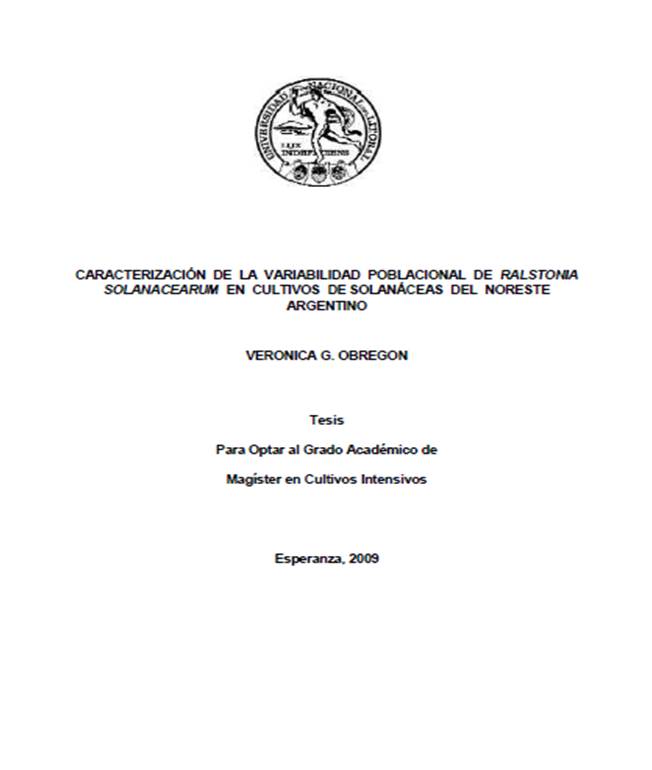Ver ítem
- xmlui.general.dspace_homeCentros Regionales y EEAsCentro Regional CorrientesEEA Bella VistaTesisxmlui.ArtifactBrowser.ItemViewer.trail
Caracterización de la variabilidad poblacional de Ralstonia solanacearum en cultivos de solanáceas del Noreste argentino
Resumen
Entre los síntomas de enfermedades que afectan el cultivo de tomate en el Nordeste Argentino se destaca el marchitamiento y muerte de plantas en distintos estados de desarrollo del cultivo. Los antecedentes en el mundo que registran este síntoma lo atribuyen a la bacteria Ralstonia solanacearum, citada en el Nordeste Argentino en forma sucinta ya hace unos años. La importancia del cultivo de tomate y la reproducción de estos síntomas, observados también
[ver mas...]
Entre los síntomas de enfermedades que afectan el cultivo de tomate en el Nordeste Argentino se destaca el marchitamiento y muerte de plantas en distintos estados de desarrollo del cultivo. Los antecedentes en el mundo que registran este síntoma lo atribuyen a la bacteria Ralstonia solanacearum, citada en el Nordeste Argentino en forma sucinta ya hace unos años. La importancia del cultivo de tomate y la reproducción de estos síntomas, observados también en pimiento y berenjena establecieron la hipótesis de Ralstonia solanacearum como el agente causal del marchitamiento en las solanáceas mencionadas. Se obtuvieron aislados de tomate, berenjena y pimiento del servicio de diagnóstico del laboratorio de Sanidad Hortícola y recolecciones de campo para determinar la presencia de R. solanacearum y establecer la raza y biovar de la misma. Para ello se transfirieron los aislados obtenidos a tetrametil-trifenil-tetrazolium (TTC), se estableció la reacción de hipersensibilidad (RH) en hojas de tabaco, se realizaron tests bioquímicos, pruebas de patogenicidad y la reacción en cadena de la polimerasa (PCR) respecto a cepas de referencia obtenidas para este fin. Se trabajó con 36 aislados que formaron colonias fluidas, redondas, blancas y levemente rojas al centro en TTC; no produjeron RH en tabaco y las cepas de tomate y berenjena causaron reacción de alta patogenicidad en el huésped y entre ellos, mientras que los aislados de pimiento dieron valores intermedios. Se identificaron los aislados como R. solanacearum biovar 1 y 2 por la producción de ácido a partir de lactosa, maltosa y celobiosa; la reacción negativa de manitol, sorbitol y dulcitol y por la técnica PCR, que amplificó un fragmento de la banda 718 bp del gen 16S ARN ribosomal de R.solanaceraum de todas las cepas en estudio. El trabajo desarrollado permitió confirmar la presencia de R. solanacearum biovar 1 y/o 2 en todos los aislados de tomate, pimiento y berenjena no descriptos hasta el presente y citar pimiento y berenjena como nuevos huéspedes en la región nordeste de Argentina.
[Cerrar]
Among the diseases affecting the tomato crop in Northeast of Argentina highlights the wilting and death of plants. This symptom is attributed to the bacterium Ralstonia solanacearum. They were isolated from tomato, eggplant and pepper sent to the laboratory of vegetable disease and field collections to determine the presence of R. solanacearum biovar race and set the same. This isolates obtained were transferred to tetramethyl-triphenyl tetrazolium (TTC)
[ver mas...]
Among the diseases affecting the tomato crop in Northeast of Argentina highlights the wilting and death of plants. This symptom is attributed to the bacterium Ralstonia solanacearum. They were isolated from tomato, eggplant and pepper sent to the laboratory of vegetable disease and field collections to determine the presence of R. solanacearum biovar race and set the same. This isolates obtained were transferred to tetramethyl-triphenyl tetrazolium (TTC) was established hypersensitivity reaction (HR) in leaves of tobacco, biochemical tests were performed, and pathogenicity tests chain reaction (PCR) compared to reference strains obtained for this purpose. We worked with 36 isolates, none occurred in tabacco and RH strains of tomato and eggplant caused highly pathogenic reaction in the host and between them, while pepper isolates gave intermediate values. Isolates were identified as R. solanacearum biovar 1 and 2 by acid production from lactose, maltose and cellobiose, the negative reaction of mannitol, sorbitol and dulcitol and the PCR, which amplified a fragment of 718 bp band 16S ribosomal RNA gene of R . solanaceraum of all strains under study. The work confirmed the presence of R. solanacearum biovar 1 and / or 2 in all isolates of tomato, pepper and eggplant not described so far, and pepper and eggplant cited as new hosts in the northeastern region of Argentina.
[Cerrar]

Director de Tesis
Rista, Mario Luis;
Descripción
Tesis para optar al grado académico de Magíster en Cultivos Intensivos, de la Universidad Nacional del Litoral, en octubre de 2009.
Fecha
2009-10-23
Editorial
Facultad de Ciencias Agrarias, Universidad Nacional del Litoral
Formato
pdf
Tipo de documento
tesis de maestría
Palabras Claves
Derechos de acceso
Abierto
 Excepto donde se diga explicitamente, este item se publica bajo la siguiente descripción: Creative Commons Attribution-NonCommercial-ShareAlike 2.5 Unported (CC BY-NC-SA 2.5)
Excepto donde se diga explicitamente, este item se publica bajo la siguiente descripción: Creative Commons Attribution-NonCommercial-ShareAlike 2.5 Unported (CC BY-NC-SA 2.5)


